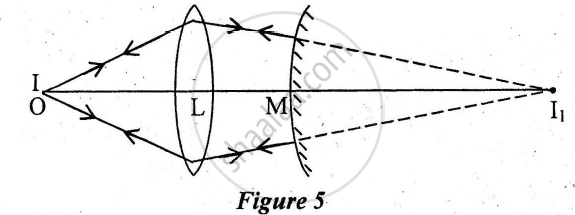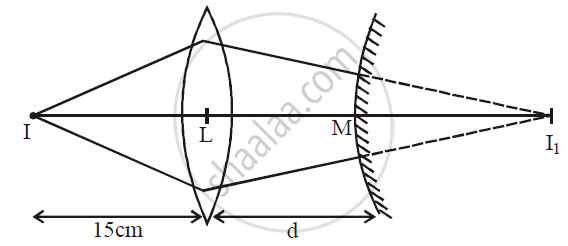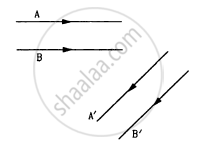Advertisements
Advertisements
Question
A point object O is placed at a distance of 15cm from a convex lens L of focal length 1 Ocm as shown in Figure 5 below. On the other side of the lens, a convex mirror M is placed such that its distance from the lens is equal to the focal length of the lens. The final image formed by this combination is observed to coincide with the object O. Find the focal length of the convex mirror

Solution

u = 15 cm
f = 10 cm
d = f = 10 cm
For lens, `1/V - 1/u = 1/f`
`1/V - 1/((-15)) = 1/10`
`1/V = 1/10 -= 1/15 = (3-2)/30 = 1/30`
V= 30 cm
MI = LI - LM = 30 - 10 = 20 cm
`f = 20/2 = 10 cm`
APPEARS IN
RELATED QUESTIONS
a) Give two reasons to explain why reflecting telescopes are preferred over refracting type.
Use the mirror equation to deduce that the virtual image produced by a convex mirror is always diminished in size and is located between the focus and the pole.
following Figure shows two rays A and B being reflected by a mirror and going as A' and B'. The mirror
A light ray falling at an angle of 45° with the surface of a clean slab of ice of thickness 1.00 m is refracted into it at an angle of 30°. Calculate the time taken by the light rays to cross the slab. Speed of light in vacuum = 3 × 108 m s−1.
A small object is placed at the centre of the bottom of a cylindrical vessel of radius 3 cm and height 4 cm filled completely with water. Consider the ray leaving the vessel through a corner. Suppose this ray and the ray along the axis of the vessel are used to trace the image. Find the apparent depth of the image and the ratio of real depth to the apparent depth under the assumptions taken. Refractive index of water = 1.33.
A light ray is incident normally on the face AB of a right-angled prism ABC (μ = 1.50) as shown in figure. What is the largest angle ϕ for which the light ray is totally reflected at the surface AC?

Name the physical principle on which the working of optical fibers is based.
For paraxial rays, show that the focal length of a spherical mirror is one-half of its radius of curvature.
The focal length f is related to the radius of curvature r of the spherical convex mirror by ______.
An upright object is placed at a distance of 40 cm in front of a convergent lens of a focal length of 20 cm. A convergent mirror of focal length 10 cm is placed at a distance of 60 cm on the other side of the lens. The position and size of the final image will be ______.
